Lukashenko’s Pawns
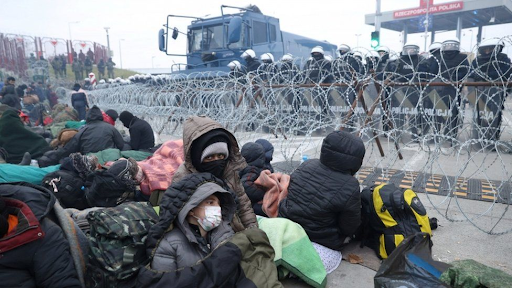
Photo Source: BBC.com
December 15, 2021
Thousands of people stand in a freezing cold forest, gazing across barbed wire at what was supposed to be their promised land. It was supposed to save them; supposed to be a chance at a better life for them and their children. Instead, their hopes are dashed by an endless line of armored soldiers whose sole purpose is to keep them from entering their desired destination.
These people are immigrants, coming from developing countries and seeking better opportunities elsewhere. They were lured to this remote border in Eastern Europe as a piece in an ongoing political game.
In what is being called a “hybrid attack,” one country has channeled this migration of people to put pressure on the border of a neighboring country.
Now, as winter deepens, and the countries they have found themselves between continue to jockey, these people are stuck between a rock and a hard place. Sickness is spreading, cold is setting in, and people are dying.
The immigrants are left with two choices. First, they can take a flight back to a place that can hardly be called “home.” The second option is to stay where they are and hope that their use as a weapon will somehow turn into the admittance that they have wanted all along.
Parties Involved
There are three major groups that play into the situation unfolding in Europe. The first is the immigrants stuck between the countries of Poland and Belarus. The roughly 10,000 migrants inside Belarus originate from various Middle Eastern and African countries, with a majority coming from the Kurdish region of Iraq.
These people are fleeing war-torn and poverty-stricken countries with hopes for better lives within the European Union (Abbreviated EU). The goal for many is to reach Germany, one of the main countries in the EU and a western neighbor to Poland.
The second of the groups is Belarus, the alleged perpetrator of the crisis. Belarus is under an authoritarian government ruled by “Europe’s Last Dictator,” Alexander Lukashenko. According to accusations by the EU and other countries, Belarus facilitated the entrance of immigrants in order to route them towards the Polish border and disrupt the European Union.
Then there is the third group, consisting of Poland and the European Union. It is into the EU that the immigrants are trying to reach. Poland is a member state of the EU, while Belarus is not, meaning that getting into Poland from Belarus is the big step towards settling within the EU.
The second group, Belarus, and the third, the EU, stand at odds. Their relationship has only deteriorated in recent years. Lukashenko has continuously made it clear to the EU that Belarus buffers their eastern border from immigration, and it could cease to do so if it chose. It now seems that he has done just this. Lukashenko has used the first group, the hopeful immigrants, against his opponents as a wave of disorder.
Location of the Crisis
The crisis is unfolding on the shared border of Belarus and Poland, two eastern European countries. Belarus immediately borders Russia to the East, Lithuania and Latvia to the North, Poland to the West, and Ukraine to the South.
Immigrants are concentrated in the Belarus capital, Minsk, and on the border with Poland. Minsk houses the only Belarusian international airport.
The border between Belarus and Poland exists in one of “Europe’s oldest and densest forests” (Monika Pronczuk, NYT). As winter sets in, the temperatures are dropping and hypothermia is a huge risk.
Poland and Belarus’ border separates more than just the two countries. Poland is a member of the European Union, while Belarus is not, making the border a divider of Europe’s greater political organization. The EU includes some of Europe’s most prosperous nations that come together on some joint policies. Generally, the goal of the immigrants is to make it within the EU.
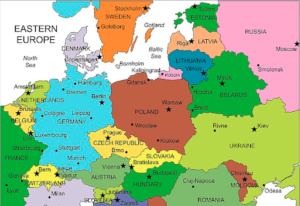
Path of the Immigrants
Belarus has been accused of creating this immigrant crisis by making it easier to enter their country, and then bringing immigrants to the Polish border from Minsk.
In the past year, Belarus has taken actions that ease the process of immigrating from Middle Eastern countries. Belarusian airline Belavia has added flights to Istanbul in the last year, and the country has also made it easier for foreigners to acquire a visa. Visitors from 76 countries have now been allowed to come to Belarus visa-free for 30 days.
Once in Belarus, it has been reported that human traffickers and Belarusian troops brought immigrants to the border and concentrated them there. Videos from Belarusian media and accounts from immigrants tell that they were guided through the forest to the Polish border.
Countries seeing an influx of these immigrants on their Belarusian borders, like Poland and Lithuania, also report that evidence found with detained immigrants suggests that they have been taken to the border through Belarusian efforts.
Once at the border, immigrants have also claimed that Belarusian forces are supplying them with implements to cut through fences, and instructions to cross into Poland.
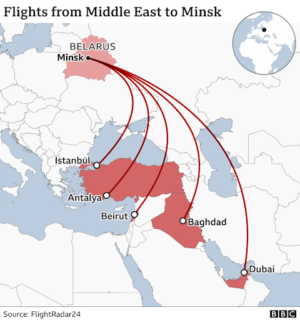
Lukashenko’s Motivation
The entire crisis has allegedly been facilitated by the Belarusian government and Alexander Lukashenko, with only Belarus and Russia denying this. Belarus’ recent relationship with the EU gives some insight into how this could have happened.
Over the past year, Lukashenko has been facing mounting pressure from the European Union for his governance. In Belarus’ recent election last year, Alexander Lukashenko declared victory in a disputed and suspect verdict. The EU did not recognize Lukashenko’s claim to office, and his own people protested in the streets of the Belarusian capital, Minsk. These protests were violently suppressed, and thousands of arrests were made.
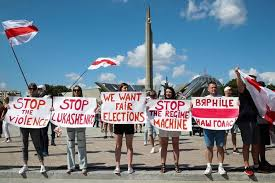
Then, in May of 2021, a European commercial flight carrying a known opposition journalist of the Belarusian government was forced to land in Minsk specifically so he could be arrested. European powers responded by calling the incident a “state-sponsored hijacking” (Anton Troianovski NYT).
Lukashenko’s incitement of this crisis likely stems from bitterness over his and Europe’s relations in recent times, despite it being caused by his actions.
Lukashenko would have chosen to use an immigration crisis to destabilize Poland’s border due to the topic of migration’s controversial nature within the EU. Immigration is a divisive topic within the European Union. Eastern vs Western Europe deals with different kinds of migration levels, and different groups within countries battle over internal migration policy.
Poland’s Response
The reaction from Poland to the immigrants on its border has been severe, as it has completely shut down its perimeter along Belarus. The country considers the crisis as a grave threat to national security and is treating it as such. Poland has amassed 20,000 police, military, and border patrol officers along Belarus.
The Polish are repelling immigrants with riot gear, barbed wire, and water cannons. No one is being allowed across, and any caught on the Polish side of the border are being detained and sent back.
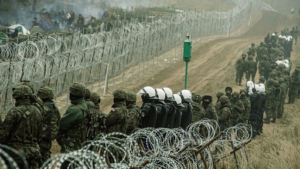
Poland has also recently ratified an exclusion law at the border. Following the expiration of a state of emergency that has been in place since the summer, the Polish government is excluding any access to the border. This exclusionary law limits the ability of humanitarian organizations and reporters to reach the immigrants.
Poland is also now planning a permanent 5.5 meter-high border wall with Belarus.
Reaction to the Reaction
Belarus has responded to Poland’s stiff-arm by allowing immigrants to leave the border if they wish but is not forcing people to leave in any way. Meanwhile, elements in Europe are upset with the Polish reaction to the crisis.
Belarus is demanding that Germany accepts 2,000 immigrants but has not been given a response by the EU member state.
Belarusian President Alexander Lukashenko visited the warehouse where immigrants have been staying on the Polish border in late November. He told them that they would not be forced home and should continue to try and cross if they wish.
According to Reuters, Lukashenko told the huddled immigrants: “We will work together on your dream,” and “it’s up to you” whether to stay or not.
“Go through. Go.”
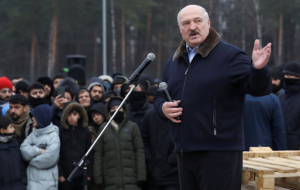
Those that wish to leave, however, have been able to. Currently, the Polish government estimates 3,000 immigrants have been repatriated and 7,000 remain in Belarus.
The remaining immigrants themselves, and likely some that left Belarus, have nowhere to go. Most have given all of their money (that was typically raised by selling everything they had back home) to human traffickers to get them to the Polish border. Now that no one is getting across, the smugglers are only raising their prices and leaving the immigrants to their fates.
These fates have turned out to be dire ones, with the claimed death toll standing at around a dozen, with more believed to be dead or hospitalized.
With no money, belongings, or safe home to return to, those stuck in Belarus are gritting their teeth and remaining at the border. “There’s no going back”
Meanwhile, Poland and the EU have faced questions from humanitarian organizations on the handling of the border situation.
Some have questioned the legitimacy of a Polish law that allows border forces to return anyone found crossing the border seeking asylum.
Criticism has also surfaced over the EU’s proposal of increasing the time Belarus’ border countries will be allowed to have to handle immigrants in processing centers. Typically, the time frame is 4 weeks, but the EU is looking to raise this to 16.
Summarizing the backlash on Belarus, Poland, and the EU, Erin McKay of the charitable organization Oxfam says that “supporting the detention of immigrants at EU borders puts politics over people’s lives”
Outlook
As of December 8, 2021, some immigrants are being flown out of Belarus while others remain. Poland maintains a presence on the Belarusian border, and Alexander Lukashenko continues to deny responsibility for the crisis. Both countries and the EU as a whole face international scrutiny for the handling of the situation.
This crisis has done little to improve the worsening relationship between Belarus and the European Union, contributing to the overall tension existing in Eastern Europe.
Alexander Lukashenko has made himself into an international villain in the eyes of many by allegedly using immigrants to destabilize Poland’s border and the EU’s internal peace.
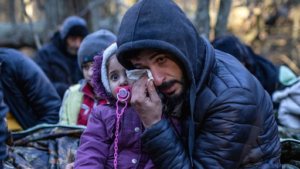
The immigrants themselves are the victims of this situation, having left everything for a chance that was likely a lie all along. They are left to either return to their countries of origin, or remain in poor conditions in Belarus, awaiting the slim possibility that they will be allowed in.
Overall, the immigrant crisis on the Polish-Belarusian border leaves no winners, as international politics seems to have implemented people’s lives as a tool to settle a score.
